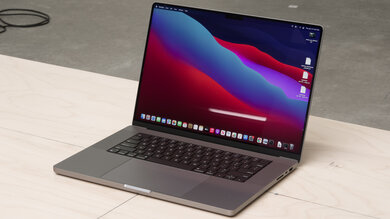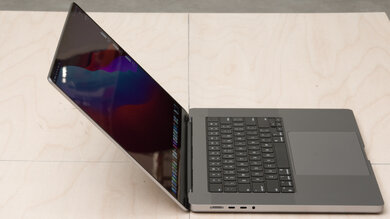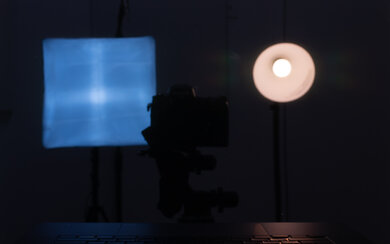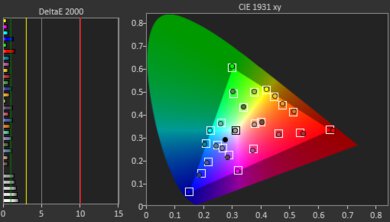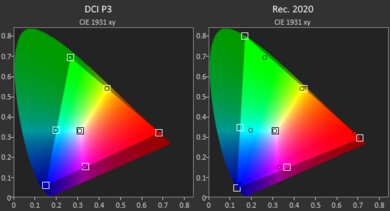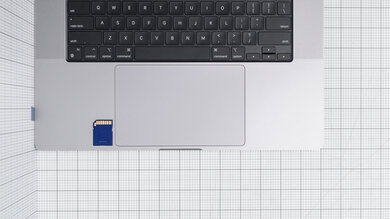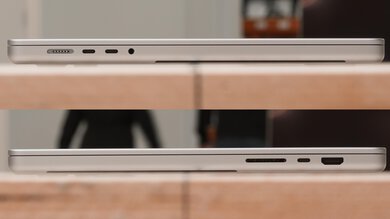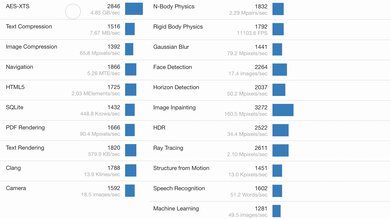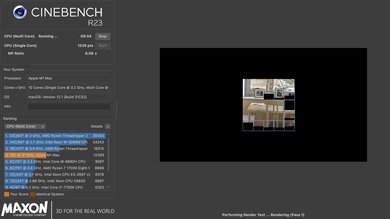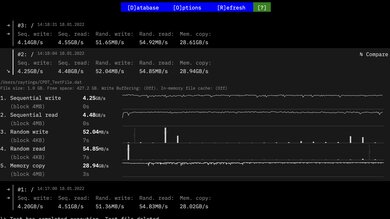The Apple MacBook Pro 16 (2021) is a premium laptop featuring Apple's M1 Pro and M1 Max SoCs (System on a Chip). It has a 16 inch display like its predecessor, the Intel-based Apple MacBook Pro 16 (2019); however, this newer model has a Mini LED backlight, and it can adaptively ramp up the refresh rate up to 120Hz for smoother motion. The display is sharp and color-accurate, and it gets more than bright enough to deliver a true HDR experience. The keyboard feels great to type on, the touchpad is large and responsive, and the webcam's video quality is outstanding, producing a well-exposed and detailed image for video calls. It has a wide port selection, including a full-size HDMI port, USB-Cs with Thunderbolt 4 support, and an SD card reader. Its M1 Max SoC can handle nearly every type of workload with ease, and due to its power efficiency, the battery life is fantastic, lasting 15 hours of light productivity. Although the M1 chip has enough graphical horsepower to run demanding games, performance can vary wildly as very few games are optimized for its ARM-based SoC. Also, the display's response time is slow, causing noticeable blur trails behind fast-moving objects.
Our Apple MacBook Pro has an M1 Max SoC with 10 CPU cores and 32 GPU cores, 32GB of unified memory, and 512GB of storage. If you have a lighter workload that doesn't require as much graphical processing power, you can configure the MacBook Pro with an M1 Pro chip with 16 GPU cores or an M1 Max chip with 24 GPU cores. However, the choice of the SoC limits the memory configuration options as you can only pair the M1 Pro models with 16GB or 32GB of memory, while the M1 Max models are available with 32GB or 64GB. The M1 Max chip has other features like a wider memory bandwidth and more video encoders and decoders, so depending on your workload, it might be worth getting the M1 Max over the M1 Pro.
Our Verdict
The Apple MacBook Pro is excellent for school use. It feels exceptionally well-built thanks to its full-aluminum chassis, and its battery lasts easily through a typical school day with plenty of charge to spare. It's on the heavy side, though, so it's a bit cumbersome to carry around. The display gets bright enough to combat glare, the keyboard feels great to type on, and the touchpad is responsive. Its M1 SoC can handle graphically demanding workloads, making it suitable for students in fields like graphic design or 3D animation.
- Exceptionally well-built.
- Battery lasts 15 hours of light productivity.
- Display gets bright enough to combat glare.
- Large and responsive touchpad.
- Excellent webcam video quality for video calls.
- Heavy weight makes it less portable.
- No USB-A ports for wired peripherals.
The Apple MacBook Pro has the hardware to run demanding games; however, very few games are optimized for its ARM-based M1 SoC, and running games through Rosetta 2 may result in poor performance or graphical glitches. Also, the response time is quite slow even though it has a 120Hz panel, resulting in noticeable ghosting in fast-moving scenes. On the upside, there's very little performance loss over time, and it doesn't get overly hot or loud under load.
- Excellent port selection includes a full-size HDMI and Thunderbolt 4 ports.
- SoC can handle demanding workloads like video editing and gaming.
- Fast storage drive.
- Minimal performance loss over time.
- Slow response time causes noticeable ghosting.
- Few games optimized for ARM-based M1 SoC.
- No USB-A ports for wired peripherals.
The Apple MacBook Pro is great for media consumption. It has a sharp and colorful display that gets bright enough for a true HDR experience, and thanks to its Mini LED backlight providing local dimming, it can display deep blacks. The speakers get reasonably loud, and they sound full and well-balanced with minimal compression artifacts. Battery life is excellent as it lasts over 8 hours of video playback, enough time to get through a couple of movies and TV show episodes. As for portability, it's relatively thin and compact for a 16 inch device, but it's on the heavy side.
- Screen displays accurate colors and supports wide color gamut.
- Can display deep blacks for better dark room viewing experience.
- Gets very bright in HDR.
- Full-sounding speakers.
- Battery lasts over 8 hours of video playback.
- No touch input.
The Apple MacBook Pro is excellent as a workstation. Its M1 Max SoC can handle nearly all types of workloads, including demanding tasks like video editing and 3D rendering. It also doesn't get overly hot or loud under load and doesn't throttle much over time. It has plenty of ports, including a full-size HDMI, USB-Cs with Thunderbolt 4 support, and an SD card reader, though you'll still need dongles for your USB-A peripherals. Unfortunately, you can't upgrade the memory or storage after purchase as the battery is the only user-replaceable part.
- Excellent port selection includes a full-size HDMI and Thunderbolt 4 ports.
- Screen displays accurate colors and supports wide color gamut.
- SoC can handle demanding workloads like video editing and gaming.
- Fast storage drive.
- Minimal performance loss over time.
- No USB-A ports for wired peripherals.
The Apple MacBook Pro is great for business use. Even though it's slightly heavy, it's still fairly thin and compact for a 16 inch device and should fit into most bags. The keyboard feels comfortable to type on, the touchpad is gigantic and responsive, and the webcam's video quality is excellent. Its port selection includes a full-size HDMI port should you need to connect to an external display for presentations, but you'll still need dongles for your USB-A peripherals. Its M1 Max SoC can handle most tasks like text formatting, web browsing, and spreadsheets with ease, and thanks to its power efficiency, the battery lasts easily through a typical 8-hour day with plenty of charge to spare.
- Exceptionally well-built.
- Excellent port selection includes a full-size HDMI and Thunderbolt 4 ports.
- Battery lasts 15 hours of light productivity.
- Display gets bright enough to combat glare.
- Large and responsive touchpad.
- Excellent webcam video quality for video calls.
- Heavy weight makes it less portable.
- No USB-A ports for wired peripherals.
Changelog
- Updated Dec 07, 2023: Converted to Test Bench 0.8.2.
- Updated Nov 03, 2023: Converted to Test Bench 0.8.1.
- Updated Aug 01, 2023: We've uploaded a new photo in the Touchpad section because the laptop wasn't properly aligned with the grid in the previous photo.
- Updated Nov 08, 2022: Added mention of the MSI WS76 (2021) in the Screen Specs section as an alternative with a larger display.
Differences Between Sizes And Variants
We tested the Apple MacBook Pro 16 with an M1 Max SoC (10 CPU cores, 32 GPU cores), 32GB of memory, and 512GB of storage. The SoC, memory, and storage are configurable; you can see the available options in the table below. This review only applies to the 16 inch model as we'll review the 14 inch model separately.
| Screen |
|
|---|---|
| CPU |
|
| GPU |
|
| Memory |
|
| Storage |
|
| Color |
|
Our display and performance results are only valid for the configuration we tested. If you come across a different configuration option not listed above, or you have a similar Apple MacBook Pro 16 inch that doesn't correspond to our review, let us know, and we'll update it. Some tests, like black uniformity and color accuracy, may vary between individual units.
You can see our unit's label here.
Popular Laptop Comparisons
The Apple MacBook Pro is a premium laptop that stands out for its build quality, performance, and power efficiency. It also has arguably one of the best displays on the market, and it continues to set the standard when it comes to laptop speakers and touchpads. However, it's very expensive compared to Windows laptops with similar performance. Also, while it can handle graphically demanding games, few titles are optimized for its ARM-based SoC, so it isn't the best option if your main goal is to play games.
The Apple MacBook Pro 16 (M3, 2023) is a newer version of the Apple MacBook Pro 16 (M1, 2021). Except for a new Space Black color, they're identical in design, as all the improvements are internal. The M3 MacBook Pro 16 has a slightly brighter display, better performance, and longer battery life. The M3 Pro/Max SoCs also add hardware-accelerated ray tracing, AV1 decoding, and increased memory support (up to 128GB).
The Apple MacBook Pro 14 (M1, 2021) is a smaller variant of the Apple MacBook Pro 16 (M1, 2021). They're nearly identical in many aspects, but there are a few differences. The MacBook Pro 16's display is larger, giving you more screen space for multitasking. Its bigger chassis allows for a larger touchpad, better-sounding speakers, and more effective cooling on the SoC, leading to better performance over time. That said, it's more cumbersome to carry around. The MacBook Pro 16 has longer battery life for productivity, but it doesn't last as long for video playback. As for the configurations, the MacBook Pro 14 has a lower-end M1 Pro option with 8 CPU cores and 14 GPU cores that isn't available on the 16 inch model.
The Apple MacBook Pro 16 (M1, 2021) is much better than its predecessor, the Apple MacBook Pro 16 (2019). The 2021 model features Apple's ARM-based M1 Pro and M1 Max SoCs, which are significantly more powerful than the Intel 9th Gen Core CPUs on the 2019 model. The M1's integrated graphics perform better than the dedicated GPUs available on the older model. The M1 MacBook Pro's display is much better as it has a Mini LED backlight that provides local dimming and gets a lot brighter in HDR. The M1 MacBook Pro's keyboard feels better to type on, its webcam's video quality is better, and its wider port selection includes a full-size HDMI port and SD card reader. Last but not least, the M1 MacBook has significantly longer battery life, lasting five hours more than the 2019 model for light productivity.
Although there are many design similarities between the Apple MacBook Pro 16 (M1, 2021) and the Apple MacBook Air 15 (M3, 2024), these two laptops have quite a few differences in features and performance. The MacBook Pro 16 is a workstation designed for demanding tasks like content creation, while the MacBook Air is an ultraportable designed for light, general productivity tasks. The MacBook Pro 16 is better overall since it has more premium features, like a 120Hz Mini LED display, better-sounding speakers, a wider port selection, and longer battery life. You can get better performance from the MacBook Pro 16 even though it sports an older M1 Pro/Max SoC. The MacBook Air 15 can handle some video editing, but the experience won't be as smooth as on the MacBook Pro, especially if the material is highly complex.
Test Results

The Apple MacBook Pro has a sleek and professional look, with a full-aluminum build that feels very premium. It has up-firing speakers on both sides of the keyboard and a gigantic glass touchpad. Unlike previous MacBooks, there's a notch at the top of the screen to house the camera, but it isn't noticeable if you use a dark background in dark mode as it blends into the menu bar. There was an issue with the notch hiding items in the menu bar; however, it seems to have been resolved via a firmware update. The exhaust vents are at the bottom back edge of the device.
The Apple MacBook Pro's hinge is outstanding. It has a little more resistance than previous MacBooks, but the increased resistance doesn't cause any issues and only makes it feel stronger and more durable. There's no play in the hinge, and the screen is almost completely still when typing.
The Apple MacBook Pro is decently portable. It's fairly thin and compact for a 16 inch device, but it's on the heavy side. The power adapter isn't overly bulky, either, and should fit easily into most bags. If you want a more portable version of this laptop, check out the Apple MacBook Pro 14 (2021).
The Apple MacBook Pro has poor serviceability. To access the internals, you have to remove eight P5 screws, pry the panel open with a tool, pull the panel towards to bottom of the laptop, and then upwards to remove it. Unfortunately, the only replaceable part is the battery, and it requires a lot of effort to get it out. It's certainly better than previous MacBooks, but not by much. If you want a workstation with user-replaceable memory and storage, check out the Dell Precision 5560 (2021). Opening the laptop and changing the hardware may void the manufacturer's warranty.
The Apple MacBook Pro's screen displays exceptionally sharp images and text thanks to its high pixel density. The notch isn't part of the 16:10 display, so you aren't losing any screen real estate. The space beside the notch is extra space that now holds the menu bar. We'll review the 14 inch Apple MacBook Pro separately. If you want a mobile workstation with an even larger display, check out the MSI WS76 (2021).
The Apple MacBook Pro's display supports ProMotion, meaning its refresh rate can ramp up to 120Hz depending on the task or content on the screen, like variable refresh rate. This adaptive technology makes motion appear smoother and the system more responsive, but it also helps extend battery life when the content on the screen is inactive. It does work similar to other VRR technologies; however, the application needs to support it to be functional. It's worth noting that you can't set the refresh rate to a fixed 120Hz as there's only a 'ProMotion' setting for any refresh rate above 60Hz.
As for the response time, it's quite slow, which results in very noticeable blur trails behind moving objects. The 120Hz refresh rate does improve the clarity of the image, though, as you can see the difference in this 60Hz motion blur photo. We also took a photo of the Blur Busters UFO test, which you can see here.
The Apple MacBook Pro has a superb contrast ratio. Its high contrast is largely due to its Mini LED backlight (10,000 Mini LEDs) providing local dimming to produce deeper blacks. The posted number was measured with our checkerboard pattern, but we also measured the contrast using a full white and full black screen in HDR and obtained a contrast ratio of 100,149:1. The contrast ratio can vary between individual units.
The Apple MacBook Pro's maximum screen brightness is great. It gets bright enough to combat glare in most settings, even outdoors in broad daylight. The screen also gets very dim to provide a more comfortable dark room viewing experience.
As the Apple MacBook Pro is the first Apple laptop to feature a Mini LED backlight with an advertised 1000 cd/m² sustained brightness and 1600 cd/m² peak brightness, we've done some additional testing using our TV and monitor methodology. For the most part, the SDR brightness is extremely consistent, with only a small dip in the 2% windows, which is barely noticeable. In HDR, the brightness does vary depending on the scene, but even the dimmest windows are still above 1100 cd/m², which is more than enough for a true HDR experience.
SDR Brightness:
- 2% Peak: 442.7 cd/m²
- 2% Sustained: 441.4 cd/m²
- 10% Peak: 501.2 cd/m²
- 10% Sustained: 500.3 cd/m²
- 25% Peak: 501.2 cd/m²
- 25% Sustained: 500.8 cd/m²
- 50% Peak: 502.1 cd/m²
- 50% Sustained: 501.4 cd/m²
- 100% Peak: 501.7 cd/m²
- 100% Sustained: 501.0 cd/m²
HDR Brightness:
- 2% Peak: 1384.9 cd/m²
- 2% Sustained: 1375.9 cd/m²
- 10% Peak: 1625.3 cd/m²
- 10% Sustained: 1614.0 cd/m²
- 25% Peak: 1633.0 cd/m²
- 25% Sustained: 1613.2 cd/m²
- 50% Peak: 1595.9 cd/m²
- 50% Sustained: 1572.4 cd/m²
- 100% Peak: 1178.4 cd/m²
- 100% Sustained:1170.3 cd/m²
Regarding the local dimming, there's some blooming when viewing the screen at an angle, but it's much less noticeable when looking at the screen straight on. You can see the local dimming in this video.
The Apple MacBook Pro has adequate horizontal viewing angles. Colors look washed out when viewed from the side, so you have to be directly in front of the screen or close to it to get the best image accuracy.
The Apple MacBook Pro 16 inch has decent vertical viewing angles. The image looks inaccurate from above and below, but you still have some play to tilt the screen to your preference before image quality degrades.
The Apple MacBook Pro has superb color accuracy out of the box. The small amount of color and white balance inaccuracies aren't noticeable to the naked eye. The color temperature leans on the cooler side of our 6500k target, but it's only slightly and isn't enough to make much difference visually. The gamma follows the sRGB curve for the most part except in dark scenes where it seems to stick to a flat 2.2, so dark scenes appear darker than they should. Color accuracy can vary between units.
The Apple MacBook Pro has an outstanding color gamut. It has full sRGB and DCI P3 coverage, making it suitable for content creators working in those color spaces. Its Adobe RGB coverage is excellent, but it might not be good enough for professional photo editing as it can't display the most saturated greens. Its Rec. 2020 coverage is adequate, roughly the same as the Apple MacBook Pro 16 (2019).
We also tested the display's gradient handling. Using the same pattern and testing methodology as our monitor reviews, the Apple MacBook Pro scores a 10 out of 10 for gradient handling as there's no banding whatsoever.
The Apple MacBook Pro has a great keyboard. The keys are well-spaced, and there are no issues with the layout, so it shouldn't take long to adapt to typing on it. The keys don't require much force to actuate and provide good tactile feedback; however, they have a short travel distance, which some people might not like, and they're not the most stable. Typing noise is minimal and shouldn't be bothersome to others around you. The backlight is adjustable, but only through macOS' control panel or settings.
The Apple MacBook Pro has a superb touchpad. It's large, but it isn't in the way and doesn't cause any issues with the palms touching it while typing. It tracks all movements and gestures well, and since it uses haptic feedback to simulate the clicks, you can click anywhere on the touchpad, making it easier to perform actions like dragging and dropping items.
The Apple MacBook Pro has great speakers. They sound well-balanced, with good vocal presence and a remarkable amount of bass extension, especially for laptop speakers. They get reasonably loud, and there's minimal dynamic range compression at max volume.
There are many reports of users experiencing crackling and popping sounds when playing back media. It's likely a software bug as some users have found workarounds, like leaving QuickTime open in the background or changing the audio sample rate to 44.1KHz. Apple will likely resolve this through a firmware update; we'll update the review when it's available.
The Apple MacBook Pro's webcam video quality is outstanding. The image is well-exposed and detailed, and the colors look natural. Audio sounds loud and clear over its three-mic array with very little background noise.
The Apple MacBook Pro has an excellent port selection. All three USB-C ports support Thunderbolt 4 (up to 40Gbps data transfer rate), USB 4 (up to 40Gbps), charging, and video output via DisplayPort. The M1 Pro chip supports up to two 6k @ 60Hz displays, while the M1 Max chip supports up to three 6K @ 60Hz and one 4k @ 60Hz external displays. There aren't any USB-A ports, so you'll likely need dongles for wired peripherals. Some users have reported that it sometimes takes a long time for the system to detect the SD card, or the SD card causes Finder to crash. However, we didn't experience these issues, and it seems to only happen with older SD cards.
We can't confirm which wireless adapter the Apple MacBook Pro uses.
The Apple MacBook Pro is available with an M1 Pro or M1 Max SoC (System on a Chip). The CPU part of the SoC is the same for both chips, with both having eight performance cores and two efficiency cores. However, they differ in the number of GPU cores, memory bandwidth, and the number of hardware video encoders and decoders. The M1 Pro has a 200GB/s memory bandwidth, one video decoding engine, one video encoding engine, and one ProRes encoding and decoding engine. The M1 Max has a 400GB/s memory bandwidth, one video decoding engine, two video encoding engines, and two ProRes encoding and decoding engines.
Both chips can handle almost all tasks, from simple web browsing to demanding production workloads like video editing and 3D rendering. The CPU performance is similar between the two chips, so choosing between the M1 Pro and M1 Max depends on whether you need the extra GPU cores, memory bandwidth, or video encoding and decoding engines.
There's an M1 Pro chip with 8 CPU cores, but it's only available on the 14 inch MacBook Pro, which we'll review separately.
The GPU is integrated into the M1 Pro and M1 Max SoC. The M1 Pro only has a 16-core GPU option, while the M1 Max has a 24- and a 32-core option. Our model has the top-end configuration with 32 cores. There's no dedicated VRAM because the CPU and GPU draw from the same memory pool. Unlike most integrated graphics, the M1's GPU can theoretically use as much of the unified memory as it needs for graphical assets, although the system likely reserves some for basic functions.
Again, choosing between the three GPU options depends largely on your workload. The more cores the GPU has, the faster it can complete tasks. As for gaming, the M1's GPU can handle demanding games, but very few mainstream titles are optimized for Apple silicon, meaning you have to run games through Rosetta 2 or use a third-party solution, which sometimes results in poor performance or graphical glitches. Regarding games from the App Store, beware that even though a game is advertised as compatible with Macs running on Apple silicon, it doesn't necessarily mean it has been optimized, meaning it might be running through Rosetta 2. However, games included in the Apple Arcade subscription service will run well as they're mobile games coded for ARM-based SoCs.
The memory configuration options depend on which SoC you choose. You can configure the M1 Pro models with 16GB or 32GB and the M1 Max models with 32GB or 64GB. This memory is shared between the CPU and GPU, so it might be worth getting the 64GB option if you work in VRAM-heavy applications.
You can configure the Apple MacBook Pro with 512GB, 1TB, 2TB, 4TB, or 8TB of storage. To get the 512GB storage option with an M1 Max SoC on Apple's website, you have to first select the M1 Pro option with 512GB SSD storage, then manually upgrade the SoC to an M1 Max.
The Apple MacBook Pro's M1 Max SoC performs exceptionally well in the Geekbench 5 benchmarks. Its single-thread performance is remarkable and in the same ballpark as the Apple MacBook Air 13 (M1, 2020), which is expected as they essentially have the same core architecture. However, the M1 Pro and M1 Max chips perform significantly better in multi-threaded applications and workloads as they have a higher core count with more performance cores. Our model's M1 Max with 32 GPU cores has an excellent score in the GPU compute test. The performance is comparable to dedicated GPUs like the NVIDIA GeForce RTX 2060 (mobile), which is incredibly impressive for integrated graphics.
Overall, the M1 Pro or M1 Max's CPU can handle nearly every type of workload. The main difference is graphical performance; the more cores the GPU has, the smoother the experience will be in graphically intensive workloads. Also, keep in mind that the M1 Max has more hardware encoders and decoders than the M1 Pro, which will significantly improve performance in applications that benefit from specialized hardware acceleration.
We ran the benchmarks in the 'Automatic' power mode with the laptop plugged in and the battery at 100%. We ran them again in the 'High Power' mode to see if there's any difference, but we obtained the same numbers as in the 'Automatic' power mode. The system likely switches to 'High Power' mode when the battery reaches a certain percentage with the laptop plugged in.
The Apple MacBook Pro has remarkably high scores in Cinebench R23's CPU rendering tests. Its single-thread performance is fantastic, and like in Geekbench 5, it's about the same as the Apple MacBook Air 13 (M1, 2020). It's in multi-thread rendering that the M1 Max and M1 Pro chips pull ahead, nearly doubling the performance of the M1 MacBook Air and also handily beating the Apple MacBook Pro 16 (2019) with an Intel Core i9-9880H. Overall, the M1 Pro and M1 Max chips are more than capable of handling any CPU rendering or related tasks.
The Apple MacBook Pro's performance in Blender is good as the CPU renders the bmw27 scene quickly. We expect the CPU performance of the M1 Pro chip to be in the same ballpark. Blender doesn't support GPU rendering on Apple Silicon at the time of writing, but it's in the works, so we'll test it as soon as there's an official version with proper support available to the public.
The Apple MacBook Pro with a 32-core GPU has outstanding performance in Basemark GPU. However, real-world gaming performance depends entirely on whether a game is optimized for Apple silicon. In well-optimized games, the M1 Max with a 32-core GPU performs close to a laptop NVIDIA GeForce RTX 3080, but in unoptimized games running through Rosetta 2, the performance is more comparable to a laptop RTX 3050Ti. The M1 Pro with 16 GPU cores and the M1 Max with 24 GPU cores will be slower, with the M1 Pro being closer to an NVIDIA GeForce GTX 1650 (mobile). For the most part, you'll have to run graphically intensive games at 1080p to get a smooth experience, even on the top-end configuration with 32 GPU cores.
The Apple MacBook Pro's storage drive performance is outstanding. Its exceptionally fast sequential read and write speeds make transferring large files or installing a large app a breeze. It isn't as fast as the advertised speeds; however, the numbers Apple advertises are from an 8TB drive, so it's to be expected as larger SSDs tend to perform better.
Update 02/14/2022: The video playback battery test was rerun for verification because longer battery life was obtained on the Apple MacBook Pro 14 (2021), which has a smaller battery. However, the result remains the same as before.
The Apple MacBook Pro has fantastic battery life. You can easily get through a typical 8-hour workday of light productivity with plenty of charge to spare. The battery drains a lot faster for video playback, but as always, it'll likely last longer if you use native apps like Apple TV. The battery life for gaming is similar to what you'll get if you perform demanding tasks like video editing, where the CPU and GPU are pushed to near maximum capacity. It's short, but it's still better than most laptops with a similarly-performing dedicated GPU. Lastly, the M1 Max models will have shorter battery life than the M1 Pro models as the increase in the number of GPU cores drains the battery faster. Battery life varies greatly depending on usage.
The Apple MacBook Pro's performance in Borderlands 3 is sub-par. It can't reach an average of 60fps at 1080p with high graphical settings, and there are some noticeable stutters, which isn't ideal for an FPS game that requires precise aiming. You have to turn the settings down to minimum to get close to 60fps. The game will likely be near unplayable on the M1 Pro models with 16 GPU cores, with the average frame rate hovering in the 20s.
Civilization VI runs reasonably well on the Apple MacBook Pro with a 32-core GPU. The average frame rate doesn't quite reach 60fps at 1080p with high settings, but there's almost no stutter as the frame times are very consistent. You'll get a much smoother experience at low settings as the average frame rate doubles. Unfortunately, the turn time is rather slow. The M1 Pro with 16 GPU cores likely won't reach 60fps even at minimum graphical settings, but it'll still be playable because Civilization VI is a turn-based game that doesn't require fast reaction times.
CS:GO runs very smoothly on the Apple MacBook Pro at 1080p with high settings. Unfortunately, we can't capture the 1% and 0.1% low data because the software we use isn't compatible with macOS. That said, we didn't notice much stuttering. The average frame rate will be lower on models with an M1 Pro (16-core GPU) or an M1 Max with 24 GPU cores, but we expect both models to reach 60fps with minimal tweaks in the graphical settings.
The Shadow of the Tomb Raider in-game benchmark results are a bit odd. Even though the game detects a significant amount of stuttering, the stutters aren't really noticeable visually. There are likely some compatibility issues because the game isn't optimized for Apple silicon and is running through Rosetta 2. The M1 Max chip with a 32-core GPU achieves high frame rates at 1080p, but the M1 Pro with 16 GPU cores and the M1 Max with 24 GPU cores will likely struggle to get over 60 fps without some tweaks in the settings.
The Apple MacBook Pro has good thermal and noise performance. The keyboard temperature is low when idle, and the fans are completely silent. The keyboard deck does get toasty under load, but the hottest spots are near the top of the keyboard, away from where the hands usually rest. The fans are audible; however, they're fairly quiet, producing a low to mid-pitch whirring sound.
The Apple MacBook Pro has exceptional performance over time. The CPU and GPU do throttle a little, but the performance goes back up as the fans kick in and bring the temperatures down. The application we use to record the CPU and GPU temperatures doesn't work on Macs with Apple silicon, so we manually recorded the temperatures using another app. However, we aren't officially posting the results because the methodology is different, and the numbers aren't fully comparable with other laptops we've reviewed. Here are the CPU and GPU temperatures under load (average of three runs) recorded through TG Pro:
- CPU: 93°C (199.4°F)
- GPU: 88°C (190.4°F)
The Apple MacBook Pro ships with macOS Monterey (macOS 12). There aren't any pre-installed software applications other than those that typically come with macOS. If you want a Windows laptop instead, check out the Lenovo ThinkPad P1 Gen 4 (2021).
The Apple MacBook Pro 16 inch has a fingerprint sensor built into the power button at the top right corner of the keyboard. It lets you log in quickly, as well as authorize purchases in the App store or when using Apple Pay on supported sites.

